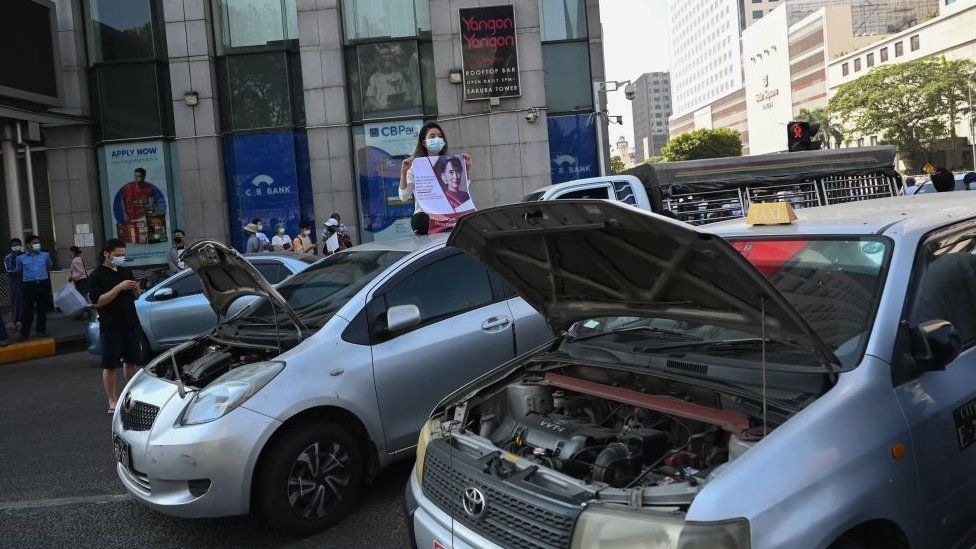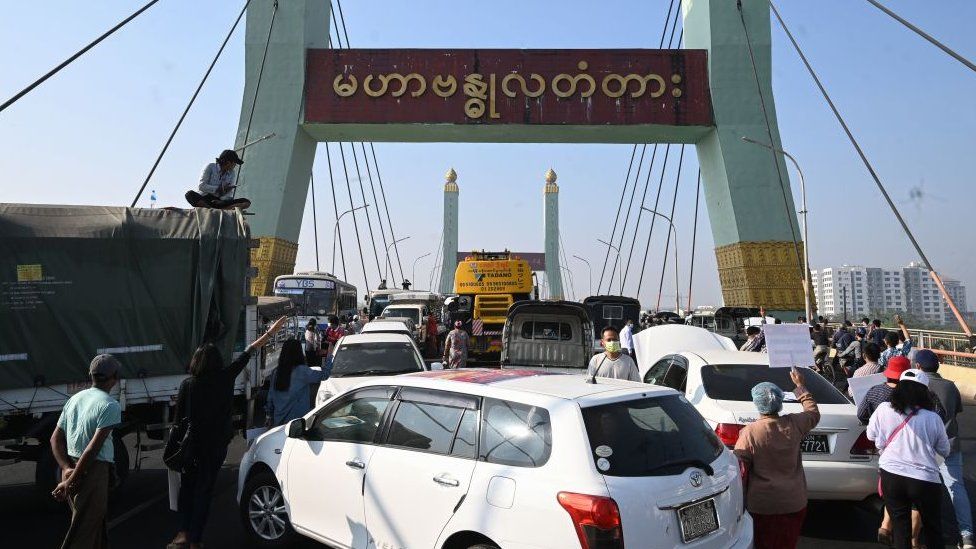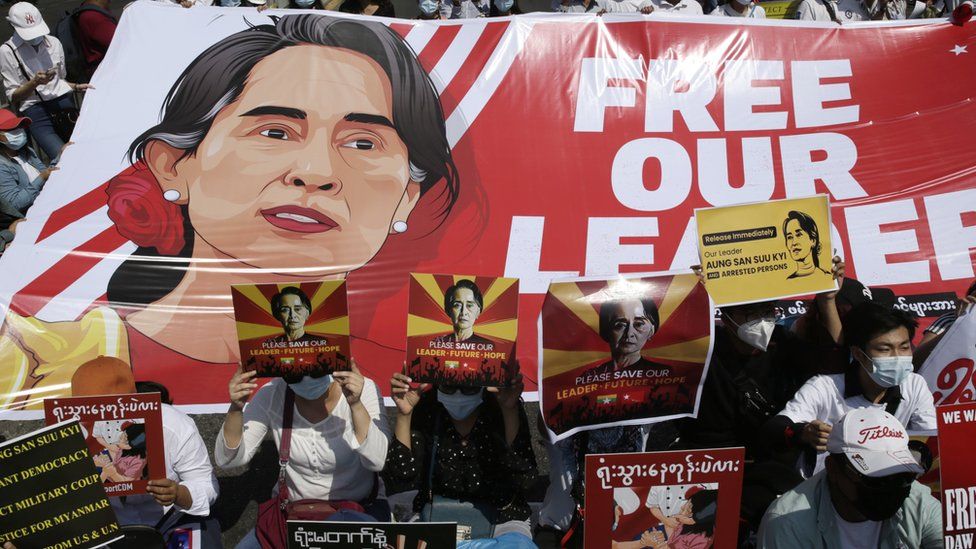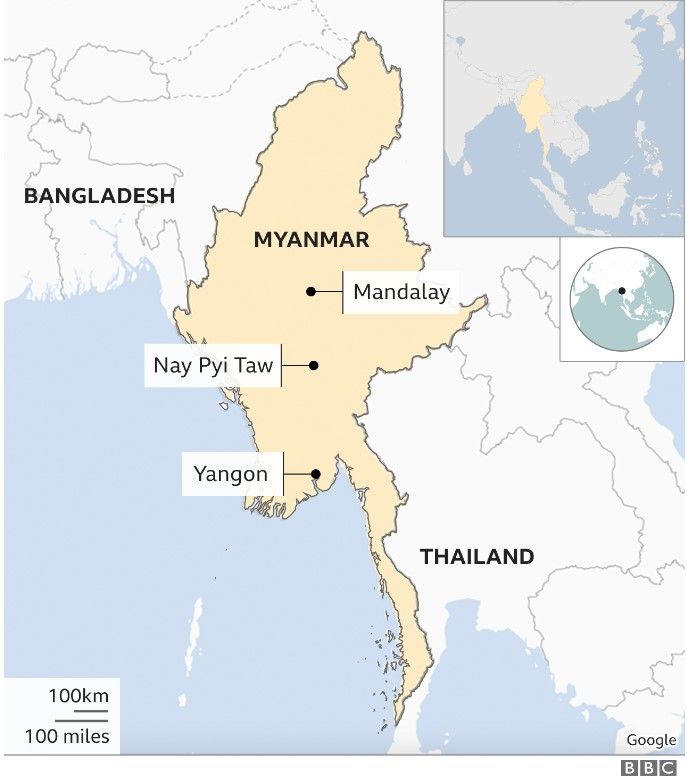Myanmar coup: Roads blocked in Yangon as thousands protest
 image copyrightGetty Images
image copyrightGetty ImagesDozens of vehicles are blocking key roads across Myanmar's main city Yangon, in what appears to be a new tactic employed by protesters.
It comes as tens of thousands of people gather downtown, in what organisers hope will be the biggest protest yet.
The UN special rapporteur for Myanmar, also known as Burma, has warned of potential violence.
Demonstrators are demanding the release of their elected leaders following a 1 Feb military coup.
Aung San Suu Kyi and other leaders have been detained by the military.
Today's protests, which have nearly paralysed traffic in downtown Yangon, come just a day after Ms Suu Kyi was handed a second criminal charge.
Myanmar's military had also on Tuesday repeated its promise to hold fresh elections and relinquish power, though many protesters remain sceptical.
'Road blocking day'
A campaign on social media calling for protesters to deliberately block roads started gaining traction early on Wednesday. Its aim was apparently to stop civil servants from going to work and hinder the movements of security forces.
Dubbed "Road Blocking Day", it has seen many posting pictures online of vehicles with raised bonnets and boots parked across several roads in Yangon, making the streets impassable to traffic.
A BBC Burmese reporter saw a number of public buses stop at junctions in Yangon and taking part in what some have called the "broken down car" movement.
The protest is the latest in a mounting civil disobedience movement in the country, which has also seen strikes by doctors and teachers, and boycotts of products and services owned by the military.
 image copyrightGetty Images
image copyrightGetty ImagesBut one activist criticised the road blockages, saying it was holding up protesters heading downtown.
"Stop the 'broken down car' and help the protesters get to Sule as soon as possible," said activist Maung Saung Kha according to a Reuters report.
Tens of thousands of people have flooded the Sule area to take part in a major protest.
Demonstrators have gathered almost every day for the past fortnight, but organisers are hoping that Wednesday's protest will see the biggest turnout yet.
 image copyrightEPA
image copyrightEPA"Let's gather in millions to take down dictators," Khin Sandar, a senior member of Aung San Suu Kyi's National League for Democracy had posted on Facebook.
"Let's march en masse [and] show our force against the coup government that has destroyed... the future of our country."
The UN Special Rapporteur on the situation of human rights in Myanmar Tom Andrews warned of "potential for violence on a greater scale" on Tuesday, adding that additional soldiers had been deployed in cities where protests were planned.
"I am terrified that given the confluence of these two developments - planned mass protests and troops converging - we could be on the precipice of the military committing even greater crimes against the people of Myanmar."
 image copyrightEPA
image copyrightEPAWhat's the background to all of this?
Myanmar's military seized control of the country on 1 February, following a general election which saw Ms Suu Kyi's NLD party win by a landslide.
It claimed that the NLD had won through fraud, and demanded a rerun of the vote - despite the electoral commission saying there was no evidence to support these claims.
Power has now been handed over to commander-in-chief Min Aung Hlaing, and Ms Suu Kyi is under house arrest.
She was earlier charged with possessing illegal walkie-talkies, and has now been accused of violating the country's Natural Disaster Law, though the details of this second charge are unclear.
Protesters are demanding the release of Ms Suu Kyi and other key NLD members - and protests over the coup have been the largest since the so-called Saffron Revolution in 2007.
But clashes have taken place between security officers and protesters, and there are reports of police using tear gas and rubber bullets to disperse crowds.
The military has also been regularly blocking the internet in a bid to stifle dissent.

Myanmar - the basics
- Myanmar, also known as Burma, was long considered a pariah state while under the rule of an oppressive military junta from 1962 to 2011
- A gradual liberalisation began in 2010, leading to free elections in 2015 and the installation of a government led by veteran opposition leader Aung San Suu Kyi the following year
- In 2017, a deadly crackdown by Myanmar's army on Rohingya Muslims sent more than half a million fleeing across the border into Bangladesh, in what the UN later called a "textbook example of ethnic cleansing"
- Aung San Suu Kyi and her government were overthrown in an army coup on 1 February following a landslide NLD win in November's elections





No comments